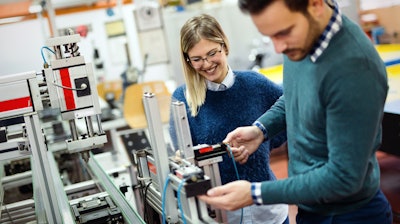
Labor Day is our New Year’s Eve. Rather than vowing to lose weight or spend less time on our phones, as college professors we head into the new school year with a different kind of resolution: to inspire and prepare our students to become agents of positive change.
The world’s problems certainly didn’t take a break this summer, and we know that successfully addressing them depends on a mindset much broader than any one discipline can offer. Our strategy is to cultivate a way of thinking that blends insights from multiple perspectives.
As a psychologist, an anthropologist and an historian who teach at an engineering college, happily, we see examples of this kind of integration all around us.
Globally
Global climate change may be the biggest challenge facing humanity, and it is a problem that illustrates the world-changing implications of interdisciplinary problem-solving. In an analysis of the economic impact of reducing greenhouse gas emissions, experts at the consulting firm McKinsey & Company identified a spectrum of strategies and their associated costs.
Options like converting to nuclear energy, shifting to electric vehicles, and retrofitting coal and gas plants all have great potential, but we can produce the most benefits for the lowest cost by adopting strategies such as switching homes to energy efficient lighting and better insulating our residences and workplaces. Compared to changing the national energy supply chain, these changes aren’t highly technical. They are matters of changing human beliefs and behavior.
An article published in Science last year diagnosed the real problem of climate change in this way: “Experiencing the self as separate from nature is the foundation of humanity’s damaged relationship to planetary resources.”
The only real solution to the climate problems facing our planet is to change mindsets, an approach that requires a complex understanding of all the ways that individuals and institutions interact with the natural world. In other words, students should not only study the social sciences or the natural sciences, but also learn how the insights gained from both can be combined to be even more powerful.
Locally
The importance of making connections across perspectives also plays out at the local level.
One traffic intersection in the center of Drachten, Netherlands, accommodates 20,000 drivers as well as many bicyclists and pedestrians each day. As a result, it became notorious for its high rate of accidents and deaths. A conventional solution might have been to load up the roads with signage and signals that clearly instruct everyone where to go and when.
But when Dutch traffic engineer Hans Monderman approached the problem, he saw the congested conduit as a place of profound disconnection. Rather than peppering the roads with signs, in 2003 he took all signage away. This approach to “shared space” design meant that drivers, cyclists and pedestrians had to increase their awareness of each other to successfully navigate the intersection.
This reliance on human connection rather than engineered traffic patterns upended conventional thinking, and dramatically decreased the number of accidents and deaths. The most innovative solutions to local problems like this demand deep integration of quantitative and emotional insights that are too often segregated between traditional academic disciplines.
Individually
Finally, we see many challenges at the individual, personal level that call out for integrated thinking.
Terri, a Boston-area woman in her 60s who uses a wheelchair, told a team in one of our engineering design classes here at Olin College of Engineering that she finds grocery shopping a cumbersome and physically painful experience. A traditional engineer’s answer might point her to online services that could provide convenient in-home grocery delivery without unpleasant exertion.
But when our students joined Terri at the supermarket, tried to navigate the store from her wheelchair, and spent time with her in her home, they discovered something unexpected. For Terri, grocery shopping wasn’t only focused on getting food, but offered a special opportunity to laugh with the butcher, exercise autonomy and experience community membership. An online service could deliver her ground turkey, but it would also make her feel lonely.
The students’ solution was a custom easily adaptable rack for the chair – painted bright purple, Terri’s favorite color – that eased the physical challenges of shopping while enhancing her ability to engage with her community in a meaningful way. Devising this solution required a nimble synthesis of engineering design and attention to human values.
Teaching New Approaches
As these examples illustrate, we need to teach students to approach complex problems differently. Our future is at stake.
This past May, a joint task force from the National Academies of Sciences, Engineering, and Medicine released a report entitled “Branches From the Same Tree: The Integration of the Humanities and Arts with Sciences, Engineering, and Medicine in Higher Education.”
This study identified the great potential in interdisciplinary education. The list of possible benefits include improved student motivation and enjoyment of learning, development of teamwork and communication skills, ethical decision-making and critical thinking.
Done correctly, engineering begins and ends with people. Done optimally, tackling our world’s biggest challenges requires a diverse and integrative approach.
We see encouraging examples of this type of innovative integration in diverse corners of academia. For example, at George Mason University, the Rain Project, part of the EcoScience + Art Initiative brought together faculty from sciences, arts, humanities and design departments to develop a floating wetland.
The project not only improved water quality and stormwater management, but also demonstrated the local community’s dependence on their wetlands for survival. Or the STAGE Lab at the University of Chicago, where new pieces of theater and film are created within the context of the Institute for Molecular Engineering. Here, the creation of new plays and films alongside the creation of new scientific findings inspires new ways of asking questions, in both art and science.
Ethics, sustainability, questions of identity, equity or social justice, and many other topics, must be included in the scientist’s or engineer’s design process. And their repertoire must include rigorous communication, teaming, self-directed learning, self-reflection and other skills. Similarly, artists, writers, managers and other non-technical professionals lose out when their work ends where scientific thinking begins.
Our Labor Day resolution this year won’t help us with weight or time management. Instead, it will help us to humbly remember the limits of any one way of thinking about major challenges and the promise of true integration.
This article was originally published on The Conversation. Read the original article here: https://theconversation.com/want-to-solve-the-worlds-problems-try-working-together-across-disciplines-102319.






















